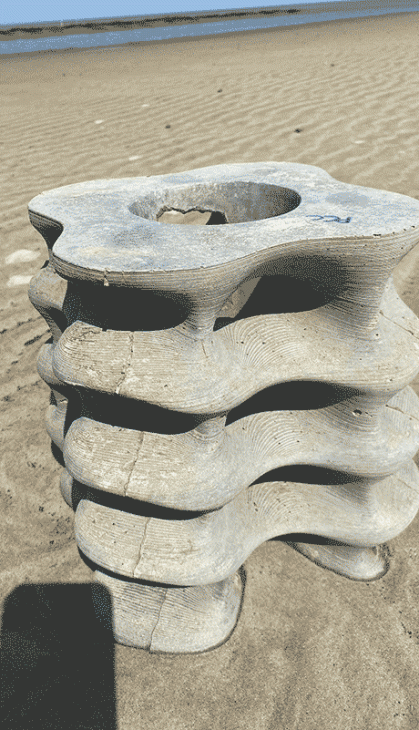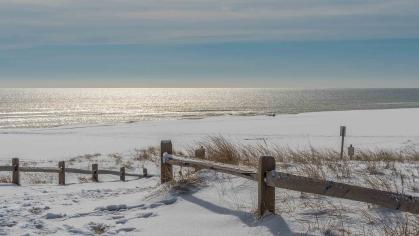Researchers, U.S. Military Install Concrete Modules With Self-Healing Oyster Reef Structure in Florida Panhandle Bay to Protect Base

The Rutgers-designed, hybrid reef-mimicking experiment could provide protection from storms and coastal flooding
U.S. Air Force officials installed a new kind of structure in the waters of St. Andrew Bay on the shore of the Tyndall U.S. Air Force Base in northwest Florida on Oct. 30 – the first section of a Rutgers University-designed “self-healing” reef made of custom-designed concrete modules and living oysters. The reef is designed to protect the base and its people from hurricanes and tidal surges.
As visitors watched, a crane lowered a segment of what ultimately will become a 160-foot-wide reef composed of about 800 interconnected concrete cubes Rutgers scientists created with colleagues collaborating from several institutions. The structures are being hoisted into shallow water about 200 feet off the shoreline.
The concrete provides a hard substrate that oysters need for attachment and is designed specifically so that more oysters will naturally gravitate to the structures over the next year, ultimately forming resilient hybrid “living” reefs.

Part of the Rutgers Reefense Team: (from left) Lead scientist David Bushek, director of Haskin Shellfish Research Laboratory; Professor of Civil Engineering Hani Nassif; Professor of Materials Science and Engineering Richard Riman; field researcher Jenny Shinn, Haskin Lab; Reid Holland, doctoral student, Nassif Lab; Michael Ruszala, master's degree student, Nassif Lab.
Air Force officials are testing the experimental reef, funded through the Reefense program of the Defense Advanced Research Projects Agency (DARPA), to assess whether it provides adequate coastal defenses against oncoming storms. The international effort involving more than 60 research centers on the development of self-healing, hybrid biological and engineered reef-mimicking structures to mitigate the coastal flooding, erosion and storm damage that increasingly threaten civilian and U.S. Department of Defense infrastructure and personnel.
Hurricane Michael, a Category 5 hurricane that devastated the Florida Panhandle in October 2018, tore apart Tyndall's hangars, damaged several supersonic stealth fighter jets known as F-22 Raptors and left much of the base in ruins.
“This experiment will document the Reefense modules’ ability to help protect and enhance the bay shoreline and make it more robust and resilient,” said lead scientist David Bushek, director of the Rutgers Haskin Shellfish Research Laboratory and a professor in the Department of Marine and Coastal Sciences in the Rutgers School of Environmental and Biological Sciences (SEBS).

Oysters grow in clusters, not as individual animals, and form natural seawalls in shallow water by attaching to each other. Such organic structures are effective protectors of shorelines but can break up during large storms, Bushek said. The hybrid living shoreline at the center of the experiment contains both human-made and natural components purposely designed to be more durable without adversely affecting the marine environment.
Bushek observed the installation, along with DARPA’s Reefense program manager Catherine Campbell and other members of the research team.
The project builds on Rutgers’ historical strength as home to the oldest and one of the world’s top oyster breeding programs. An analysis by Chinese scientists considered to be the most comprehensive to date characterized two of Rutgers’ oyster scientists as second and 15th in a ranking of the world’s most productive and prolific oyster researchers.
The effort also capitalizes on faculty members’ recent innovations in materials science, hydrodynamic modeling and what scientists refer to as “adaptive biology.” The phrase refers to the ability for organisms to change in response to environmental pressures such as warming temperatures or increasing risks of disease.
Squat and honeycombed, the two-feet-square, 450-pound modules being installed are made of a specially engineered, low carbon footprint concrete and will be covered in disease-resistant oysters bred via genomic selection. The structures are expected to stabilize and protect shorelines more effectively than natural versions.
As with the sound-absorbing cones in a soundproof room, the holes in the modules are designed to absorb and dissipate wave energy, protecting the shore beneath and the shallow area closer to the shoreline. The structures also force larger waves to break farther out, further protecting the area.

“We wanted to develop an ecologically functional, engineered structure providing the strength and longevity of hard structures while facilitating the benefits provided by organisms colonizing the modules,” Bushek said. “In doing so, we have made a lot of discoveries and advances in science and technology in the past few years. We’ve pushed the needle a lot.”
Bushek is working with Richard Riman, a Distinguished Professor at the Rutgers School of Engineering, who is the project’s co-investigator and is leading the development of the engineered reef. Collaborating Rutgers researchers include Distinguished Professor Ximing Guo and Associate Professor Daphne Munroe, both of the Haskin Laboratory and SEBS, and Hani Nassif, a professor in the School of Engineering.
Dozens of scientists and engineers from universities throughout the U.S. and Australia are active participants in the collaboration.



